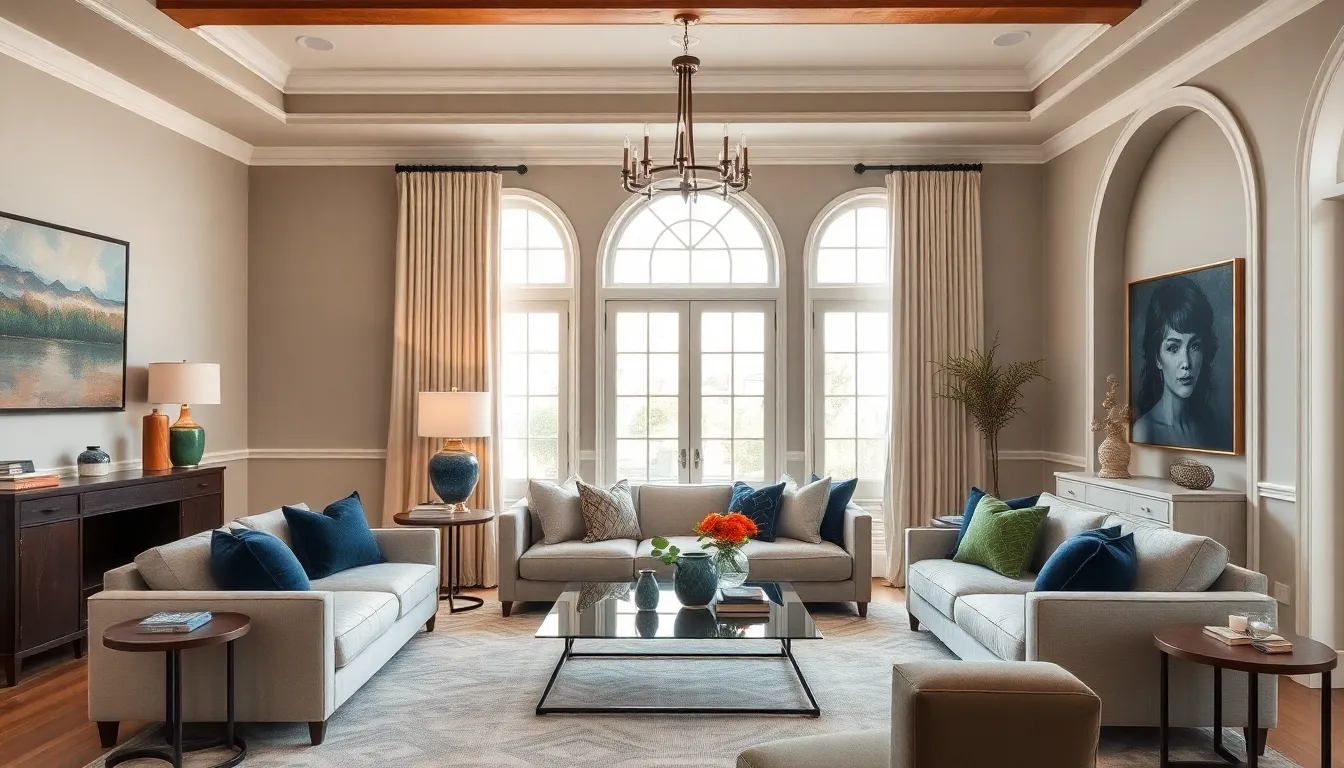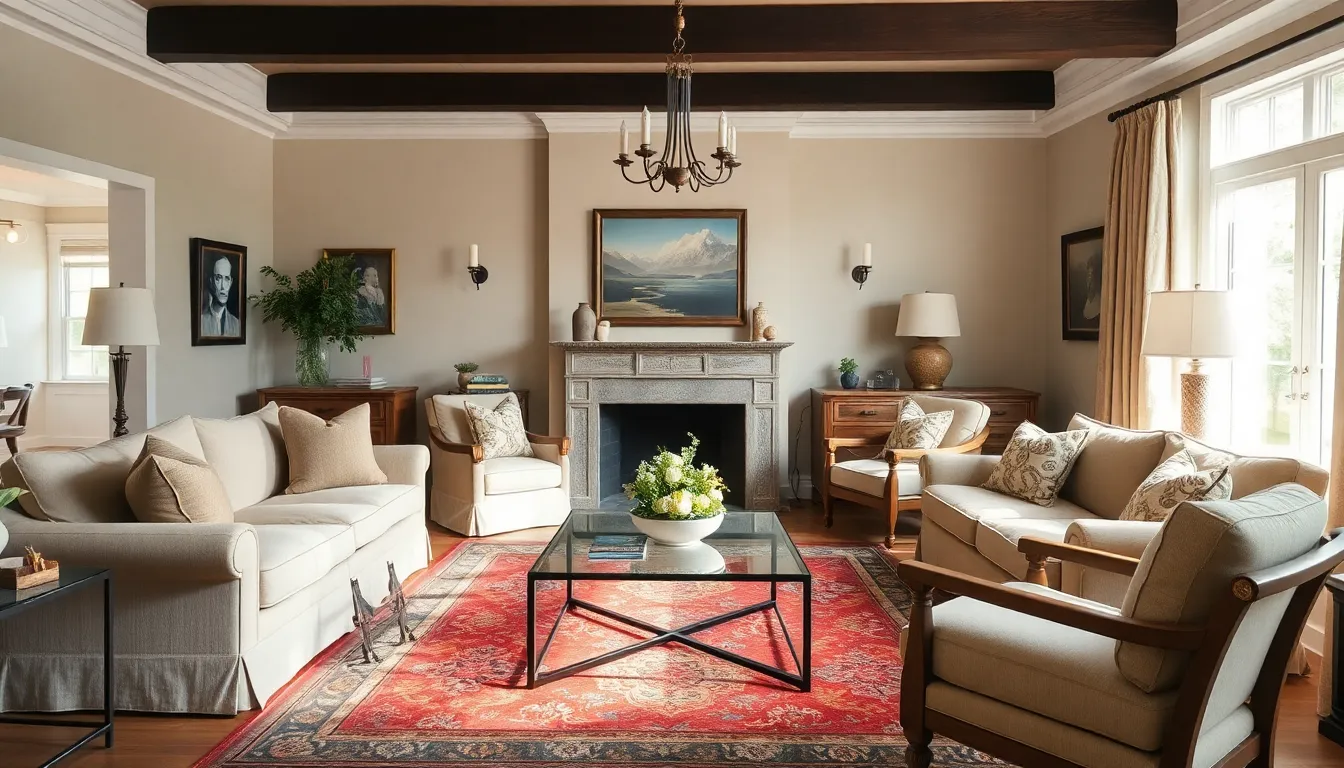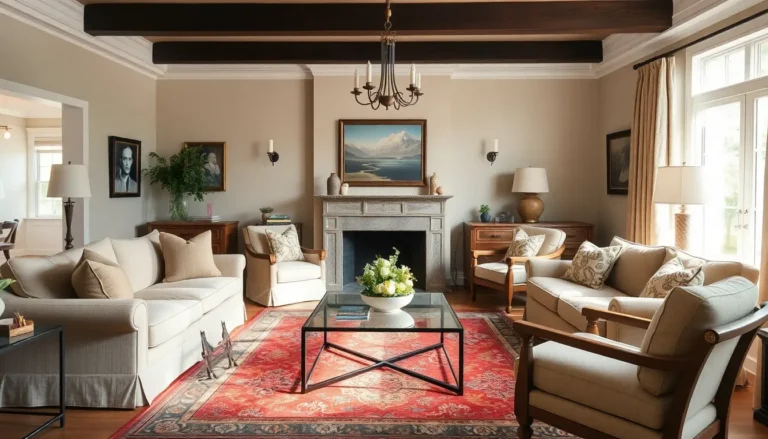Transitional decor is like the stylish chameleon of interior design, effortlessly blending the best of traditional and contemporary styles. It’s that perfect balance where classic elegance meets modern flair, creating spaces that feel both timeless and fresh. Imagine walking into a room that embraces the charm of yesteryear while still giving a nod to today’s trends—who wouldn’t want that?
This design style isn’t just a pretty face; it’s also practical. Transitional decor allows for personal expression without the risk of looking like a confused time traveler. With its versatile palette and mix of textures, it invites creativity while ensuring a cohesive look. So whether you’re a fan of sleek lines or warm, cozy vibes, transitional decor might just be the secret ingredient to elevate your home into a stylish sanctuary.
Table of Contents
ToggleUnderstanding Transitional Decor
Transitional decor serves as a bridge between traditional and contemporary styles. By balancing elegant classicism with modern elements, this design approach creates stylish spaces that feel both inviting and fresh.
Definition and Characteristics
Transitional decor combines features from various design styles, resulting in a harmonious aesthetic. It avoids extremes, favoring moderation and simplicity. Clean lines, neutral color palettes, and a mix of textures define this approach. Soft furnishings often complement structured pieces, creating comfort without sacrificing sophistication. Open spaces and uncluttered layouts enhance the airy feel. Minimal ornamentation allows for personal expression while maintaining overall cohesion.
Key Elements of Transitional Decor
Key elements shape the essence of transitional decor. Neutral color palettes often dominate the design, incorporating shades like beige, gray, and taupe. Furniture styles, such as tufted sofas and sleek coffee tables, merge traditional craftsmanship with modern functionality. Lighting plays an essential role, with fixtures that blend contemporary designs and classic materials. Accessories, including artwork and decorative objects, add personality while remaining understated. Lastly, varying textures, like plush fabrics and smooth surfaces, contribute depth and interest to the space.
Color Schemes in Transitional Decor

Transitional decor thrives on a refined color approach that balances elegance and modernity. Neutral tones form the foundation of any successful transitional space, allowing other elements to shine.
Neutral Palettes
Neutral palettes dominate transitional decor, promoting a serene and cohesive atmosphere. Colors like beige, gray, and taupe support versatility and blend effortlessly with various furnishings. Soft whites enhance the feeling of space, while darker neutrals provide depth. Layering different shades creates visual interest, making rooms feel inviting while maintaining simplicity. This balanced base allows homeowners to showcase their personal style without overwhelming the senses.
Accent Colors
Accent colors play a significant role in defining the character of transitional spaces. Deep blues, warm greens, and rich burgundies offer pops of color that contrast with neutral backgrounds. Incorporating these shades through accessories, artwork, and textiles adds personality and vibrancy. Each hue should harmonize with overall decor while drawing attention to specific areas. Effective use of accent colors highlights architectural features and creates focal points throughout the room. This thoughtful combination keeps the decor balanced, engaging, and ever-relevant.
Furniture Choices
Transitional decor emphasizes furniture that balances traditional and contemporary influences. This choice creates a harmonious aesthetic throughout the space.
Blending Styles
Mixing classic and modern furniture pieces defines transitional decor. Sofas with simple lines match elegantly with ornate accent chairs. Coffee tables may feature glass surfaces paired with wooden bases for a layered effect. Incorporating various designs maintains visual interest, allowing for personal expression. This blending of styles cultivates a cohesive environment, where both old and new coexist comfortably.
Material Selection
Choosing the right materials enhances the transitional design ethos. Upholstered fabrics like linen and velvet add softness while maintaining sophistication. Wood elements in light or dark finishes introduce warmth and structure. Glass and metal accents can punctuate the decor, bringing a contemporary edge. Pairing these materials creates a texture-rich environment that feels inviting. Selecting quality pieces ensures durability and promotes a timeless appeal that fits various lifestyles.
Accessories and Decor Items
Accessories and decor items play a vital role in defining transitional decor. They add character and warmth while enhancing the overall design scheme.
Art and Wall Decor
Art and wall decor significantly influence the ambiance of transitional spaces. Choose artwork that balances traditional themes with contemporary styles for a cohesive look. Framed photographs, abstract paintings, and classic landscape pieces can create visual interest. Gallery walls featuring a mix of frame styles also offer a modern twist on traditional display methods. Decor items like wall sconces or sculptural pieces enhance the design by merging functionality with aesthetic appeal.
Textiles and Rugs
Textiles and rugs contribute essential layers to a transitional decor style. Comfort and sophistication lie in fabric choices such as linen, cotton, and velvet. Area rugs can anchor a room while unifying color schemes and textures. Selecting rugs with subtle patterns or solid colors ensures they complement rather than overwhelm. Throw pillows and blankets featuring varying fabrics and shades create inviting nooks, enhancing both comfort and style.
Tips for Achieving Transitional Decor
Transitional decor blends modern and traditional styles effectively. This style emphasizes balance, showcasing both classic elegance and contemporary flair.
Balancing Modern and Traditional Elements
Select furniture that reflects a harmonious mix of both styles. Combine sleek, modern sofas with vintage accent chairs to create visual contrast. Incorporate modern lighting fixtures alongside traditional wooden pieces, enhancing the decor’s depth. Choose area rugs that feature both geometric patterns and classic motifs, ensuring cohesion. Find a way to create a seamless flow between rooms by maintaining a consistent color palette throughout. Prioritize comfort and functionality while exploring diverse materials, as they cultivate an inviting atmosphere.
Layering Textures and Patterns
Utilize a variety of textures to enrich the space visually. Combine smooth fabrics, like silk and cotton, with rougher surfaces, such as burlap and jute, for added complexity. Layer different patterns, including stripes and florals, to maintain interest without overwhelming the eye. Opt for accessories that similarly blend styles, including decorative pillows that mix modern designs with traditional patterns. Implement varying rug textures underfoot, juxtaposing plush options with sisal for texture variety. Ensure that each addition contributes to an inviting ambiance while fostering a harmonious overall design in transitional spaces.
Transitional decor offers a unique opportunity to create spaces that are both stylish and comfortable. By blending traditional and contemporary elements, it fosters an environment that feels timeless yet fresh. This design style encourages personal expression while ensuring a cohesive aesthetic throughout the home.
With its versatile color palettes and rich textures, transitional decor not only enhances visual appeal but also promotes a sense of warmth and sophistication. The thoughtful integration of furnishings, materials, and accessories allows for a harmonious balance that invites relaxation and enjoyment. Embracing transitional decor can transform any space into a stylish sanctuary that reflects individual taste and lifestyle.




